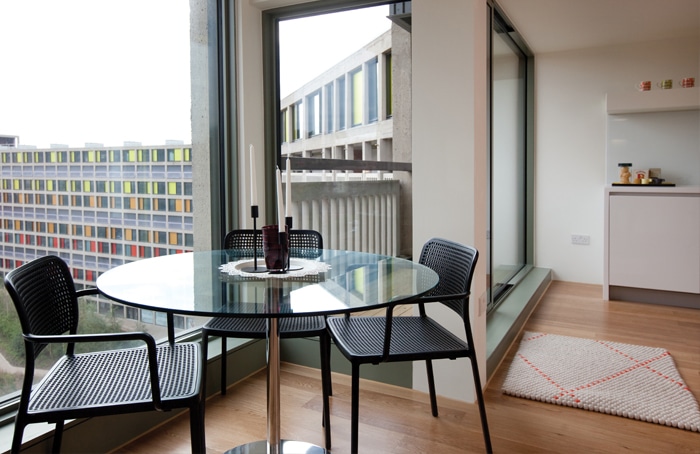 Amid reports of improving economic conditions it is encouraging to think that the outlook for the drywall sector may be looking up. However market prospects remain tough: cost pressure remains the critical factor in most contracts. Does the quest for ever lower costs result in compromised system performance and quality, and can supply chain communication help strike the right balance? Piers Roache reports.
Amid reports of improving economic conditions it is encouraging to think that the outlook for the drywall sector may be looking up. However market prospects remain tough: cost pressure remains the critical factor in most contracts. Does the quest for ever lower costs result in compromised system performance and quality, and can supply chain communication help strike the right balance? Piers Roache reports.
Andrew Richardson, technical manager at Fermacell, believes that the integrity of some system specifications has suffered in the drive to achieve savings. He says: “Often by trying to make partitioning quicker and cheaper to install, the performance of the partitioning system is vastly weakened and the overall build falls victim to added complexity, increased risk and mounting costs.”
“Modern-day commercial projects often require partitioning systems that meet several performance and regulation requirements. For example, some partitioning systems are required to hold a severe duty rating and impact resistance, as well as stringent acoustic ratings and fire-resistance at varying degrees throughout a build. Typically in these instances, projects are broken down into specific sections so architects and installers can understand and work through the different solutions needed. This kind of understanding does not come quickly or cheaply, however, and architectural planning time, as well as installer labour costs, can add lengthy delays and monetary constraint to the turnaround of any commercial project.”
Steve Halcrow, FPDC’s executive director, agrees that cost saving is an understandable objective and adds that achieving a balance with maintaining quality is fundamental. However, it’s easy for that balance to swing too far towards the desire to tighten the purse strings: “The term ‘value engineering’ has, over time, morphed from its literal meaning to one which
is simply defined as ‘making it cheaper’,” says Mr Halcrow.
“It is not usually difficult to simply buy something cheaper, but what value does it offer or add? There is nothing wrong with seeking a cheaper item, but the potential for it not to give the same value in terms of time-saving, long-term performance and so on has to be acknowledged and accounted for. The operative word here is ‘value’ – FPDC members offer a wealth of experience, skills and services, which is what makes them ‘specialist contractors’. These services, and the benefit of this experience, have an intrinsic value.”
Carefully considered co-ordination and planning along the supply chain can help to create better value, preventing costs from escalating and project schedules from slipping. Cecilia Padilla, president of construction automation management specialist On Center Software, comments: “Tracking labour costs and margin controls is essential. A QS in the UK must have the same timely access to information as a counterpart located half way around the world in Singapore for example. Everything needs to be real time and mobile. Effective collaboration is critical to the success of any construction company regardless of size.”
Steve Halcrow agrees: “It seems obvious doesn’t it? So much more is achieved, and usually far more efficiently, when human beings cooperate. And yet, all too often once the pressure of time and money takes hold and the momentum of a project is at its height, we retreat into our silos and take a blinkered view of the situation, to the detriment of the overall goal.
“Realistically, what are the chances of a designer producing the optimum solution if they are not equipped with all possible information from others involved in the process? We know the classic scenario in our sector: the absence of good co-ordination between our trade and the M&E teams always leads to damage, re-working, unnecessary repairs, and of course haggling over how we get paid for such works. Inadequate co-ordination between the various parties involved in any project is almost certain to lead to delay, cost and the quality of the output suffering.”
Andrew Richardson echoes this view: “There is a balance to be noted for manufacturers, architects and installers on simply responding to the required specification of a commercial build and looking beyond the specification stage, to how the use of their boards is going to complement and exceed the ongoing needs of the building. A difficult economic climate has brought cost and time to the forefront and while there are no expectations of this to change, simply choosing products that seem to be cheaper and easier to install at face value, does not mean that they will be value-for-money and cost-effective in the long term. For that reason, a holistic view of partitioning solutions needs to be adopted by all to find which partitioning systems can deliver multiple benefits to a build, simply and effectively.”
For drywall contracts it is clear that cheaper does not equal better value. Getting the supply chain working more co-operatively and specifying the right systems for the long term is a starting point for achieving better overall value for money. Steve Halcrow concludes: “It’s a simple fact that cost and quality are usually proportionate, and that there always comes a point at which lowering the cost tilts the equation and quality suffers. The trick is spotting where that point is and staying just on the right side of it – then you might get quality products and great value.”


